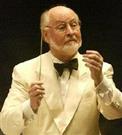|
|
||||
|
by Richard Jack Smith 
John Williams, the composer behind the Star Wars scores reviewed below, is a five-time Oscar winner. His soundtracks include: The Towering Inferno, Jaws, Close Encounters of the Third Kind, Superman, 1941, Raiders of the Lost Ark, Home Alone, Jurassic Park, Schindler’s List and The Adventures of Tintin: The Secret of the Unicorn. He also scored Star Wars: The Force Awakens, released on December 18, 2015. Episode I – The Phantom Menace (1999) ***** Although not necessarily a leitmotif or character theme, “Duel of the Fates” stands up incredibly well next to John Williams’ “Imperial March,” the music associated with Darth Vader. The inspiration for “Duel of the Fates” comes from a poem called The Battle of the Trees. Because Williams required something “Pagan” for the climax, certain words were translated into Sanskrit. This helped to define the conflict between good and evil. When the door opens, Sith apprentice Darth Maul (Ray Park) attacks Jedi warriors Qui-Gon Jinn (Liam Neeson) and Obi-Wan Kenobi (Ewan McGregor). Musically, Williams adds so much to this sequence. For instance, the chorus sparks an emotional fury. It’s neither overpowering nor prolonged. Of course, an encore might have been nice. Wisely, he expanded this material for another memorable encounter during Revenge of the Sith. Personally, I prefer “Duel of the Fates” to “The Imperial March.” Why? Because it expresses the duality between positive and negative forces. While Vader’s theme reveals a singular darkness, it lacks the gentler side that would make it complete. Other highlights include “Anakin Defeats Sebulba” and “Hail to the Winner, Anakin Skywalker.” While the former reveals Williams’ penchant for rousing melodies, the latter tips the hat to Erich Wolfgang Korngold. In particular, The Adventures of Robin Hood heralded some major trumpet performances which Williams took to heart. Episode II – Attack of the Clones (2002) ***** Regarding action music, there are some significant points of reference. For example, check out “Battle on the Ice” from Sergei Prokofiev’s Alexander Nevsky and “Dar the Hero” from Robert Folk’s Beastmaster 2: Through the Portal of Time. Both tracks convey a heavy sense of burden, mixed with easy going heroism. Joining their ranks, Williams presents “Zam the Assassin and The Chase Through Coruscant.” The latter’s placement during Attack of the Clones proves to be a digital turning point. Various forces inside the orchestra (no pun intended) nearly crash into one another. Notably, an electric guitar appears around 3:20. Briefly, this instrument conveys a breathless quality before the drums on the left and right channels receive their own workout. When the guitar returns, it’s a cool addition which feels seamless. Conveying innocent longing, “Across the Stars” represents one of the finest themes from the prequel trilogy. Above all, it propels the forbidden love between Padmé (Natalie Portman) and Anakin (Hayden Christensen). Because they must keep their romance a secret, Williams develops the music along the lines of a sacred and potentially dangerous core. Episode III – Revenge of the Sith (2005) ***** Sophisticated tones and harmonies draw us into “Star Wars and the Revenge of the Sith.” This 7½ minute cue touches upon heroism and peril in the finest John Williams tradition. What a rousing start to a great album. Meanwhile, “Anakin’s Dream” offers a reprise of the main love theme (“Across the Stars”) before a whirlwind of strings and chorus disrupts the pleasantries. At 1:14, we hear some initial rumblings of impending darkness. Likewise, “Battle of the Heroes” doesn’t waste a note. By contrast, “Anakin’s Betrayal” depicts the vanishing face of conscience in the presence of ultimate evil. Such an operatic treatment stays consistent with the Wagnerian aesthetic, and it made A New Hope, The Empire Strikes Back and Return of the Jedi rather striking. Approximately 60 seconds into “General Grievous,” an easy pace suddenly turns frenetic. It’s interesting to note the similarity in Williams’ action writing here compared with The Lost World: Jurassic Park. Both operate on the basis of strong emotion, anchored by dynamic movement. Packed with atmospheric dissonance, “Palpatine’s Teachings” feels slightly off-kilter. At 1:37, dark undertones similar to Hans Zimmer and Lisa Gerrard’s Gladiator (“Am I Not Merciful?”) echo the Sith Lord’s influence. Also, you might recognise a subdued version of the “Imperial March” around 2:37. Finally, “A New Hope and End Credits” brings back some familiar ideas. We hear themes for Princess Leia and Luke Skywalker. Because these are pop culture icons, Williams wisely doesn’t overplay the gesture. Therefore, the final prequel can link up seamlessly with A New Hope. |
||
|
© 2024 - ReelTalk Movie Reviews Website designed by Dot Pitch Studios, LLC |



